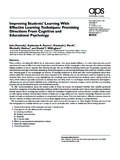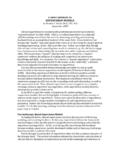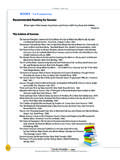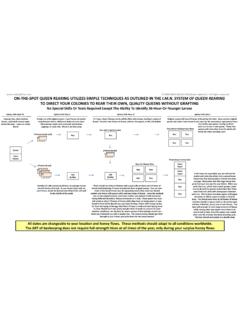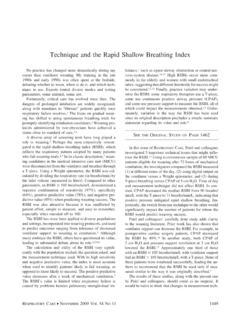Transcription of Techniques for Success 2008 / 2009 - NSIP
1 Team Builders & Icebreakers: Techniques for Success 2008 / 2009 ACKNOWLEDGEMENTS Florida High School/High Tech Team Builders & Icebreakers: Techniques for Success , 2008 / 2009 Edition This Florida HS/HT Team Builders & Icebreakers manual was compiled by The Able Trust, also known as the Florida Governor s Alliance for the Employment of Citizens with Disabilities. The Able Trust is a 501c3 public-private partnership foundation established by the Florida Legislature in 1990. Its mission is to be the leader in providing Floridians with disabilities fair employment opportunities through fundraising, grant programs, public awareness, and education.
2 Since its establishment The Able Trust has awarded over $22 million in grants to individuals and nonprofit agencies for employment-related purposes. Its programs enable over 2,000 Floridians with disabilities to enter the workforce each year. The Florida High School/High Tech Program thanks all of the partners who have worked so diligently and passionately over the past twelve years to provide high quality transition services to Florida youth with disabilities. The National Collaborative on Workforce and Disability/Youth has identified five Guideposts for Success based on what research tells us that all youth need to transition to adulthood successfully.
3 Each activity in the Team Builders & Icebreakers manual is based on one or more of the five Guideposts for Success and is intended to provide ideas for supplemental workshop activities and not to replace the use of activities in the National HS/HT Program Manual nor the Florida HS/HT Activity Guide (formerly the Florida HS/HT Sample Curriculum). Florida HS/HT is part of the national HS/HT initiative and is funded in Florida by The Able Trust, a nonprofit foundation providing employment support for Floridians with disabilities, and the Florida Department of Education s Division of Vocational Rehabilitation. The national HS/HT Initiative is supported by the Department of Labor, Office of Disability Employment Policy (ODEP).
4 2 TABLE OF CONTENTS COVER TABLE OF ICEBREAKER TEAMBUILDING WORKSHOP WRAP UP APPENDIX I: CONVERSATION 3 4 SECTION I: ICEBREAKER ACTIVITIES 5 NETWORKING BINGO SET UP: Networking is a great icebreaker at the very beginning of a training session or after lunch. As people trickle into the room, hand out the form. This activity allows a trainer to start the program on time and still integrate latecomers. The exercise can help get the day off to a good start with groups as small as 10 or as large as 150. To get the best response, modify the categories on the form to fit the group you are working with.
5 DEBRIEFING: Keep it fun and simple. One way is to form a large circle. Call out a category. The people who share that category run to the center of the circle and give each other high fives. You can ask the group that has to prove their category to sing the theme song to Casablanca, do a few steps of ballroom dancing, or show you the holes in their socks. [Networking Bingo activity sheet located on following page.] Adapted from: Snow, Harrison. 1997. Indoor/Outdoor Team-building Games for Trainers: Powerful Activities from the World of Adventure-Based Team-Building and Ropes Courses. McGraw-Hill: New York. 6 NETWORKING BINGO ACTIVITY WORKSHEET If a person matches an item, ask him or her to initial it.
6 The first five items must be initialed by 5 different people! If the item says PROVE then the person has to prove it before you have him or her initial the item. The object of the exercise is to get all of the items initialed by someone in the group! Played in a band Can hum theme song to Casablanca {PROVE} Has an often mispronounced name {PROVE} Has been on TV Has a tattoo Has been paid to sing Is a twin Speaks two or more languages Drives a truck Has been to four or more continents Has SCUBA dived Knows ballroom dancing {PROVE} Has won an award Is wearing a sock with a hole in it {PROVE} Ran a 10K Has met a president of the USA Has acted in a play Owns an iPod Has taken a hot air balloon ride Knows a good joke {PROVE} Has hiked the Appalachian Trail (or parts of it) Rides a motorcycle Goes camping Is an internet junky Adapted from: Snow, Harrison.
7 1997. Indoor/Outdoor Team-building Games for Trainers: Powerful Activities from the World of Adventure-Based Team-Building and Ropes Courses. McGraw-Hill: New York. 7 HAVE YOU EVER? The group forms a large circle. Have each group member mark their place with a small object. (Cup, hat, keys). While everyone is marking their spots the leader is standing in the center of the circle. Consequently there is one less spot than there are people. If you are indoors with a small group have people pull chairs in a circle. Explain that this is a game like musical chairs. Instead of music, however, we will use questions. The person in the center will ask a question starting with Have you An example is, Have you ever gone kayaking?
8 If you have, you must exchange places with someone from another part of the circle who has also been kayaking. You cannot change places with someone to the immediate right or left of you. Only ask about something you have done yourself. Don t ask Have you been to Moscow? unless you ve been there. When the first question is popped, people trade places leisurely. But it quickly becomes evident that the person who moves the slowest does not have a place to go except the center of the circle. That person steps to the center of the circle and asks the next question and the fun begins as people dash to find another spot in the circle. Adapted from: Snow, Harrison. 1997. Indoor/Outdoor Team-building Games for Trainers: Powerful Activities from the World of Adventure-Based Team-Building and Ropes Courses.
9 McGraw-Hill: New York. 8 TAKE A WALK Ask players to walk around the room. From time to time, call out a particular emotion or character type and have the players change their walk to show the new emotion or character. Encourage players to exaggerate, making their movements and expressions as big as possible. Tell them that anyone watching should be able to guess right away what emotion or character was called out. Help players notice how their movements change instinctively when they act out different emotions. Point out that their hands clench when they are angry or that they take smaller steps when they are afraid. Once players get the hand of it, speed up the game to give them practice changing emotions and characters quickly.
10 Don t forget to debrief at the end of the exercise! Adapted from: Bedore, Bob. 2004. 101 Improv Games for Children and Adults. Hunter House: Alameda, California. 9 WHAT IS IT? Divide the class into small groups and have each group sit in a small circle. Hand one player in each circle an invisible ball. Ask the player to decide how big and how heavy the ball is, using facial expression and body language to show this as the group members pass the ball around the circle. After the ball has rounded the circle, hand the first player an invisible lump of clay. Ask the player to mold the clay into an object, silently acting out how to use the object, and then passing the object to the next player in the circle.

